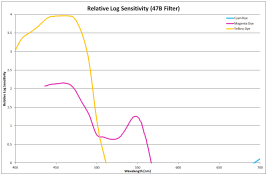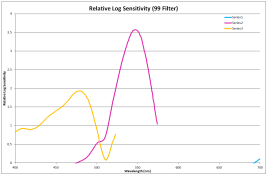gmikol
Subscriber
Ok...So I was thinking a little bit about tri-color printing, and I was looking at the spectral sensitivity curves of Crystal Archive. It seems like there's a lot of overlap between the blue-sensitive (yellow-forming) and green-sensitive (magenta-forming) dyes. It makes me wonder how one would get a really pure yellow.
So I went a step further, and convolved the dye sensitivity curves with the filter responses of tri-color printing filters. I've excluded the red-sensitive (cyan-forming) layer from this discussion, as it doesn't have any overlap with the others. So I have graphs for 47B (blue exposure), and 3 different filters for the green exposure (58, 61, 99). The curves are relative sensitivity, shifted up from the base vaules, so I could see more of the curves above the zero axis.
One shortcoming of my approach...the spectral data I had for the wratten filters (Kodak Photographic Filters Handbook, Pub. B-3) didn't go below 0.1% transmittance (3.0 density or absorbance), so I don't know exactly how strong the filters truly are in their stop-band. If any one has any more detailed spectral data, that might help a bit. I approximated everything in the stop-band as being 3.0 density.
Even with the sharpest cut filter (99), there is still appreciable overlap. So is it just a compromise or shortcoming in terms of being able to achieve a really pure yellow, or am I totally missing something (entirely possible).
Someone please straighten me out. But keep in mind I've never actually done any tri-color printing. This is as much a thought experiment as anything else.
--Greg
So I went a step further, and convolved the dye sensitivity curves with the filter responses of tri-color printing filters. I've excluded the red-sensitive (cyan-forming) layer from this discussion, as it doesn't have any overlap with the others. So I have graphs for 47B (blue exposure), and 3 different filters for the green exposure (58, 61, 99). The curves are relative sensitivity, shifted up from the base vaules, so I could see more of the curves above the zero axis.
One shortcoming of my approach...the spectral data I had for the wratten filters (Kodak Photographic Filters Handbook, Pub. B-3) didn't go below 0.1% transmittance (3.0 density or absorbance), so I don't know exactly how strong the filters truly are in their stop-band. If any one has any more detailed spectral data, that might help a bit. I approximated everything in the stop-band as being 3.0 density.
Even with the sharpest cut filter (99), there is still appreciable overlap. So is it just a compromise or shortcoming in terms of being able to achieve a really pure yellow, or am I totally missing something (entirely possible).
Someone please straighten me out. But keep in mind I've never actually done any tri-color printing. This is as much a thought experiment as anything else.
--Greg
Attachments
Last edited by a moderator:















